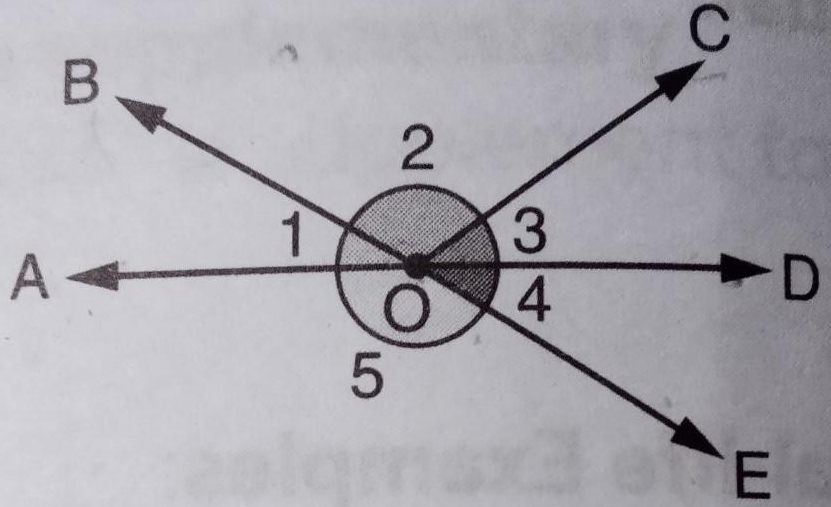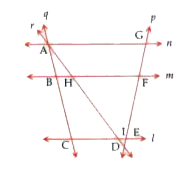In Fig. 15, write down: (i) each linear pair (ii) each pair of vertically opposite angles.
To solve the problem, we need to identify the linear pairs and vertically opposite angles in the given figure (Fig. 15). Let's go through the steps systematically.
Step 1: Identify Linear Pairs
A linear pair consists of two adjacent angles formed when two lines intersect. The sum of the angles in a linear pair is always 180 degrees.
1. Angle 1 and Angle 2: These angles are adjacent and form a linear pair.
2. Angle 2 and Angle 4: These angles are adjacent and form another linear pair.
3. Angle 4 and Angle 3: These angles are adjacent and form a linear pair.
4. Angle 3 and Angle 1: These angles are adjacent and form a linear pair.
5. Angle 7 and Angle 8: These angles are adjacent and form a linear pair.
6. Angle 6 and Angle 8: These angles are adjacent and form a linear pair.
7. Angle 6 and Angle 5: These angles are adjacent and form a linear pair.
8. Angle 5 and Angle 7: These angles are adjacent and form a linear pair.
Linear Pairs Identified:
- (Angle 1, Angle 2)
- (Angle 2, Angle 4)
- (Angle 4, Angle 3)
- (Angle 3, Angle 1)
- (Angle 7, Angle 8)
- (Angle 6, Angle 8)
- (Angle 6, Angle 5)
- (Angle 5, Angle 7)
---
Step 2: Identify Vertically Opposite Angles
Vertically opposite angles are the angles that are opposite each other when two lines intersect. They are equal in measure.
1. Angle 1 and Angle 4: These angles are opposite each other.
2. Angle 2 and Angle 3: These angles are opposite each other.
3. Angle 5 and Angle 8: These angles are opposite each other.
4. Angle 6 and Angle 7: These angles are opposite each other.
Vertically Opposite Angles Identified:
- (Angle 1, Angle 4)
- (Angle 2, Angle 3)
- (Angle 5, Angle 8)
- (Angle 6, Angle 7)
---
Final Answer:
(i) Linear Pairs:
- (Angle 1, Angle 2)
- (Angle 2, Angle 4)
- (Angle 4, Angle 3)
- (Angle 3, Angle 1)
- (Angle 7, Angle 8)
- (Angle 6, Angle 8)
- (Angle 6, Angle 5)
- (Angle 5, Angle 7)
(ii) Vertically Opposite Angles:
- (Angle 1, Angle 4)
- (Angle 2, Angle 3)
- (Angle 5, Angle 8)
- (Angle 6, Angle 7)
---
2. Angle 2 and Angle 4: These angles are adjacent and form another linear pair.
3. Angle 4 and Angle 3: These angles are adjacent and form a linear pair.
4. Angle 3 and Angle 1: These angles are adjacent and form a linear pair.
5. Angle 7 and Angle 8: These angles are adjacent and form a linear pair.
6. Angle 6 and Angle 8: These angles are adjacent and form a linear pair.
7. Angle 6 and Angle 5: These angles are adjacent and form a linear pair.
8. Angle 5 and Angle 7: These angles are adjacent and form a linear pair.
- (Angle 1, Angle 2)
- (Angle 2, Angle 4)
- (Angle 4, Angle 3)
- (Angle 3, Angle 1)
- (Angle 7, Angle 8)
- (Angle 6, Angle 8)
- (Angle 6, Angle 5)
- (Angle 5, Angle 7)
2. Angle 2 and Angle 3: These angles are opposite each other.
3. Angle 5 and Angle 8: These angles are opposite each other.
4. Angle 6 and Angle 7: These angles are opposite each other.
- (Angle 1, Angle 4)
- (Angle 2, Angle 3)
- (Angle 5, Angle 8)
- (Angle 6, Angle 7)
- (Angle 1, Angle 2)
- (Angle 2, Angle 4)
- (Angle 4, Angle 3)
- (Angle 3, Angle 1)
- (Angle 7, Angle 8)
- (Angle 6, Angle 8)
- (Angle 6, Angle 5)
- (Angle 5, Angle 7)
- (Angle 1, Angle 4)
- (Angle 2, Angle 3)
- (Angle 5, Angle 8)
- (Angle 6, Angle 7)
Topper's Solved these Questions
Similar Questions
Knowledge Check
- Question 1 - Select One
If one angle of a linear pair is acute, then the other angle is
AacuteBobtuseCrightDstraight
In Fig.18 A,B,C are collinear point and ∠DBA= ∠EBA. (i) Name two linear pairs (ii) Name two pairs of supplementary angles.
View SolutionFill in the blanks:(i) If two angles are complementary, then the sum of their measures is _______.(ii) If two angles are supplementary, then the sum of their measures is ______.(iii) Two angles forming a linear pair are _______________.(iv) If two adjacent angles are supplementary, they form a ___________.(v) If two lines intersect at a point, then the vertically opposite angles are always_____________.(vi) If two lines intersect at a point, and if one pair of vertically opposite angles areacute angles, then the other pair of vertically opposite angles are __________.
View SolutionIndicate which pairs of angles are:(i) Vertically opposite angles. (ii) Linear pairs.
View SolutionIn the adjoining figure, name the following pairs of angles.(i) Obtuse vertically opposite angles(ii) Adjacent complementary angles(iii) Equal supplementary angles(iv) Unequal supplementary angles(v) Adjacent angles that do not form a linear pair
View SolutionIn the adjoining figure, identify(i) the pairs of corresponding angles.(ii) the pairs of alternate interior angles.(iii) the pairs of interior angles on the sameside of the transversal.(iv) the vertically opposite angles.
View SolutionWrite five pairs of adjacent angles.

View SolutionIn the adjoining figure write.
(i) all pairs of parallel lines
(ii) all pairs of intersecting lines.
(iii) Concurrent lines.
(iv) Collinear points.
 View Solution
View Solution

